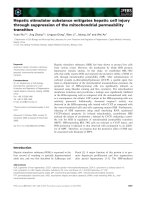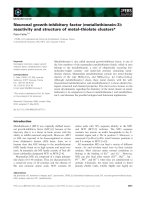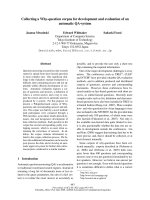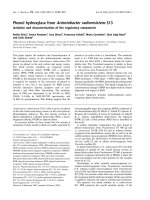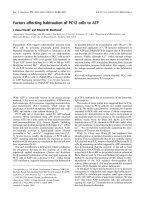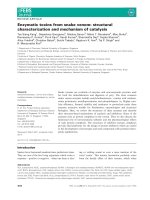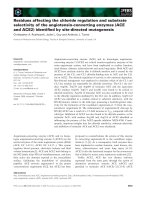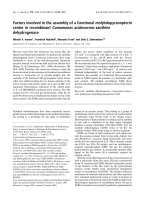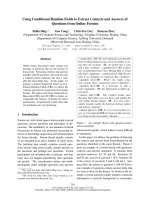báo cáo khoa học:" Factors affecting the relationship between psychological status and quality of life in COPD patients" potx
Bạn đang xem bản rút gọn của tài liệu. Xem và tải ngay bản đầy đủ của tài liệu tại đây (487.55 KB, 9 trang )
RESEARC H Open Access
Factors affecting the relationship between
psychological status and quality of life in COPD
patients
Eva Balcells
1,2,3
, Joaquim Gea
1,2,3,4
, Jaume Ferrer
3,5
, Ignasi Serra
2,6
, Mauricio Orozco-Levi
1,2,3,4
, Jordi de Batlle
2,6,7
,
Esther Rodriguez
3,5
, Marta Benet
2,6,7
, David Donaire-González
2,6
, Josep M Antó
2,4,6,7
, Judith Garcia-Aymerich
2,4,6,7*
,
the PAC-COPD Study Group
Abstract
Background: This study aims to (i) evaluate the association between anxiety and depressive symptoms and
health-related quality of life (HRQoL); and (ii) identify the effect modifiers of this relationship in patients with
chronic obstructive pulmonary disea se (COPD).
Methods: A total of 337 clinically stable COPD patients answered the St. George’s Respiratory Questionnaire (SGRQ)
(assessing HRQoL) and the Hospital Anxiety and Depression Scale (HADS). Socio-demographic information, lung
function, and other clinical data were collected.
Results: Most patients (93%) were male; they had a mean (SD) age of 68 (9) years and mild to very severe COPD
(post-bronchodilator FEV
1
52 (16)% predicted). Multivar iate analyses showed that anxiety, depression, or both
conditions were associated with poor HRQoL (for all SGRQ domains). The association between anxiety and total
HRQoL score was 6.7 points higher (indicating a worse HRQoL) in current workers than in retired individuals.
Estimates for patients with “both anxiety and depression” were 5.8 points lower in stage I-II than in stage III-IV
COPD, and 10.2 points higher in patients with other comorbidities than in those with only COPD.
Conclusions: This study sho ws a significant association between anxiety, depression, or both conditions and
impaired HRQoL. Clinically relevant factors affecting the magnitude of this association include work status, COPD
severity, and the presence of comorbidities.
Background
Health-related quality of life (HRQoL), d efined as the
degree to which a patient’shealthstatusaffectshisor
her self-determined evaluation of satisfaction or quality
of life [1], is an important pro gnostic factor in COPD
patients. Poor HRQoL has been associated with a
greater risk of hospitalisation [2] and mortality [3] in
these patients. A large body of literature examines
HRQoL correlates in COPD patients, and has particu-
larly focused on factors such as pulmonary function
impairment, exercise capacity, dyspnea, and the pre-
sence of comorbidities [4-7]. More recently, some
reviews have highlighted the negative impact of psy-
chological comorbidity on HRQoL in COPD patients
[8,9]. Specifically, previous studies of large samples of
COPD patients have found an association between psy-
chological impairment (i.e., anxiety and/or depressive
symptoms) and worse respiratory-specific HRQoL,
independent of COPD severity [10-12]. An aspect
poorly explored in previous r esearch is the identifica-
tion of effect modifiers of t he relationship betw een psy-
chological status and HRQoL. Only one earlier study
has examined the differences in the association
between anxiety and depression and HRQoL by sever-
ity groups [13]. It is currently not known whether
socio-demographic factors or comorbidities modify t he
association between anxiety and depression and the
HRQoL of COPD patients.
* Correspondence:
2
Municipal Institute of Medical Research (IMIM-Hospital del Mar), Doctor
Aiguader 88, 08003 Barcelona, Spain
Full list of author information is available at the end of the article
Balcells et al. Health and Quality of Life Outcomes 2010, 8:108
/>© 2010 Balcells et al; licensee BioMed Central Ltd. This is an Open Access article distributed under the terms of the Creative Commons
Attribution License ( which permits unrestricted use, distribution, and reproduction in
any medium, provided the original work is properly cited.
This study aimed to (1) evaluate the association
between anxiety and depressive symptoms and HRQoL
after adjusting for potential confounders and (2) identify
the effect modifiers of this relationship. Authors
hypothesised that the relationship between anxiety and/
or depressive symptoms and HRQoL in COPD patients
could be modified by certain socio-demographic and
functional characteristics of the patients. The study
includedalargesampleofstableCOPDpatientswith
mild to very severe disease, and had been designed as
an ancillary study of the larger Phenotype and Course of
COPD (PAC-COPD) project [14].
Methods
Design
This study used a cross-sectional analysis [14].
Subjects
The stud y population included all s ubjects admitted to
nine teaching hospitals in Spain for the first time for the
exacerbation of COPD between January 2004 and
March 2006. The diagnosis of COPD was confirmed by
spirometry when the patient had reached clinical stabi-
lity, at least three months after discharge; COPD was
identified as a post-bronchodilator forced expiratory
volume in one second to forced vital capacity ratio
(FEV
1
/FVC) of less than or equal to 0.7 [15]. Of the 342
patients included in the PAC-COPD study, 337 (98.5%)
had anxiety, depression, and H RQoL measures, and
therefore were included in the present analysis. The
study was approved by the ethics committees of all the
participating hospitals and all patients gave their written
informed consent. Additional details about the recr uit-
ment process have been previously published [16].
Measurements
All measurements were completed whe n patients were
clinically stable. Trained interviewers administered ques-
tionnaires to patients.
HRQoL was measured using the validated Spanish ver-
sion of St. George’s Respiratory Questionnaire (SGRQ)
[17,18]. This is a disease-specific, health-related quality of
life questionnaire consisting of 50 items with 76 weighted
responses that cover 3 domains: Symptoms, Activity, and
Impact. The “Symptoms” domain relates to the frequency
and severity of respiratory symptoms, the “ Activity”
domain relates to activities that cause or are l imited by
breathlessness, and the “Impact” domain covers aspects
of social function and psychological disturbances result-
ing from respiratory disease. A score is calculated for
each domain and a total score is calculated. The scores
range from 0 to 100 and a higher score indicates a worse
HRQoL. The “minimally important difference” in a score
that signifies a clinically significant change is consid ered
to be four points [19].
Anxiety and depression were evaluated with the
Spanish version of the Hospital Anxiety and Depressio n
Scale (HADS) [20,21]. This is a validated screening ques-
tionnaire for psychiatric morbidity that is widely used
in COPD patients [10,11,22]. This questionnaire has two
7-item subscales for anxiety and depression, respectively.
The scores range from 0 to 21 for each subscale. A score
of 8 or greater is used as the cut-off point for the identifi-
cation of anxiety and depression, meaning that indivi-
duals with even mild symptoms are considered to have
depression or anxiety in this study [20].
Limitations in activities of daily living were assessed by
the Barthel index, which quantifies independence in self-
care and mobility. The final score on the Barthel index
ranges from 0, or complete dependence, to 100, or com-
plete independence [23].
Other relevant inf ormation was also collected, includ-
ing age, gender, marital status, level of education, socio-
economic status, work activity, smoking status,
respiratory drug treatment, long-term oxygen therapy,
dyspnea (measured by using the Modified Medical
Research Council Scale, MMRC), nutritional status
(body mass index (BMI, kg/m
2
)), the Charlson comor-
bidity index, lung function (forced spirometry and
bronchodilator test, static lung volumes by whole-body
plethysmography, diffusing capacity for carbon monox-
ide (DLco) and arterial blood gases), and six-minute
walk test. Detailed information abo ut the methods and
sources of the questionn aires and the standardisation of
the tests used in the PAC-COPD study has been pre-
viously published [14,16].
Statistical analysis
Depending on the variable distribution, results are
expressed as numbers and percentages, means and stan-
dard deviations (SD), or medians and 25th or 75th per-
centiles. The patients were classi fied into four stages
of COPD severity according to the guidelines of the
European Respiratory Society and the American Thoracic
Society (ERS/ATS): mild COPD (FEV
1
≥80%); moderate
COPD (FEV
1
≥50%, <80%); severe COPD (FEV
1
≥30%,
<50%), and very severe COPD (FEV
1
< 30%) [15]. SGRQ
score, HADS score, and Barthel index were compared
across the stages of COPD severity using ANOVA or
Kruskal-Wallis (for quantitative variables) and Chi
squared or Fisher’s exact test (for qualitative variables). A
multivariate linear regression model was built for each
domain of SGRQ; anxiety and depression were the main
explicative variables and potential confounders were iden-
tified from the literature, including age, gender, marital
and socioeconomic status, level of education, work
Balcells et al. Health and Quality of Life Outcomes 2010, 8:108
/>Page 2 of 9
activity, smoking status, post-bronchodilator FEV
1
(% of
the predicted value), PaO
2
,PaCO
2
,DLco,residual
volume/total lung capacity (RV/TLC), six-minute walking
distance (6MWD), degree of dyspnea, BMI, Charlson
comorbidities, and Barthel index. All covariates with a
p-value <0.125 we re entered into a multivariate regres-
sion model, and successively excluded if they were not
associated with the outcome (p < 0.05) or its exclusion
did not modify by 10% any of the remaining estimates.
Finally, the most parsimonious model that still explains
the data was built for each outcome. Goodness of fit was
assessed through graphical study of the residuals with
specific attention paid to whether they were randomly
distributed around zero and exhibited small and constant
variance [24]. All final multivariate models were stratified
according to a list of aprioridefined potential effect
modifiers of the association between anxiety and depres-
sion and HRQoL; these potential modifiers included gen-
der, age (categorised according to the median: less than
69 years or greater than or equal to 69 years), work sta-
tus, smoking status, level of education, marital status,
socioeconomic status, severity of COPD (according to the
stages outlined by ERS/ATS [15]), and Charlson comor-
bidities. The group with “depression alone” was not
included in the stratified analyses due to the small num-
ber of subjects (n = 16). To ide ntify the variables inde-
pendently associated with psychological impairment
(anxiety, depression, or both), a multinomial (polyto-
mous) logistic regression model was built, with neither
anxiety nor depression as the reference group. The fol-
lowing confounders were tested and fina lly included in
the final model if they were independently related to the
outcome, or modified estimates for the remaining vari-
ables: age, gender, level of education, work status, marital
status, dyspnea, FEV
1
,DLco,RV/TLC,PaO
2
,PaCO
2
,
6MWD, BMI and comorbidities. Analyses were per-
formed using the statistical package SPSS 11.5 (2002,
SPSS Inc., Chicago, United States).
Results
Most patients (93%) were male and the mean age was
68 (SD: 9) years (range: 47 to 86 years); fifty-five
patients (16%) were curren t workers. A wide spectrum
of severity was found (mean (SD) post-bronchodilator
FEV
1
was 52 (16)% of the predicted value). More than
50% of the patients had two or more comorbidities, ran-
ging fr om 1 (44% of p atients) to 7 (1% of patients)
comorbidities (Table 1). Table 2 shows that SGRQ
scores increased (showing aworseningHRQoL)with
increasing COPD severity. Only 9% of patients were
dependent (Barthel index < 100), but this percentage
increasedupto24%inthosewithverysevereCOPD.
Symptoms of anxiety were more prevalent than depres-
sive symptoms (27% and 14%, respectively); thirty
patients (9%) had symptoms of both conditions. There
were no significant differences in HADS scores across
the stages of COPD.
In an adjusted m ultivariate model, lower FEV
1
, highe r
dyspnea scores, dependence, the presence of two or
more Charlson comorbidities, and symptoms of anxiety,
depression, or both, were related to a higher SGRQ
Total score (or worse HRQoL) (Table 3). In addition to
these factors, a lower BMI was associated with a higher
SGRQ Impact score, while a lower 6MWD was indepen-
dently associated with a higher SGRQ Activity score.
Female gender was associated with a lower SGRQ Activ-
ity score. The SGRQ Symptoms domain exhibited a dif-
ferent pattern of determinants; being a current worker,
having higher dyspnea scores, and both anxiety and
depression were independently associated with higher
scores. Notably, a nxiety was more strongly associated
Table 1 Socio-demographic and clinical characteristics of
337 patients with COPD
n = 337*
Males, n (%) 314 (93.2)
Age (years), m (SD) 67.9 (8.6)
Married, n (%) 272 (80.7)
Less than primary education, n (%) 139 (41.2)
Low socioeconomic status (IV-V)
†
, n (%) 255 (81.5)
Current workers, n (%) 55 (16.3)
Smoking status, n (%)
Current smoker 108 (32.8)
Former smoker 219 (66.6)
Never smoked 2 (0.6)
FEV
1
post-bronchodilator (% pred.), m (SD) 52.4 (16.2)
MMRC dyspnea scale, median (P
25
-P
75
) 2 (2-3)
RV/TLC (%), m (SD) 55.6 (10.1)
DLco (% pred.), m (SD) 65.2 (20.8)
PaO
2
(mmHg), m (SD) 74.3 (10.7)
PaCO
2
(mmHg), m (SD) 41.8 (5.3)
6MWD (m), median (P
25
-P
75
) 440.0 (390.0-508.4)
BMI (Kg/m
2
), m (SD) 28.2 (4.7)
Comorbidities: Charlson index ≥2
+
, n (%) 187 (55.8)
Any respiratory drug treatment, n (%) 288 (85.5)
Long-term oxygen therapy, n (%) 27 (8.2)
COPD, chronic obstructive pulmonary disease; FEV
1
, forced expiratory volume
in one second; MMRC, Modified Medical Research Council; RV/TLC, residual
volume/total lung capacity; DLco, diffusing capacity for carbon monoxide;
PaO
2
, partial pressure of oxygen in arterial blood; PaCO
2
, partial pressure of
carbon dioxide in arterial blood; 6MWD, 6-minute walking distance; BMI, body
mass index.
* Some variables had missing values: 24 in socioeconomic status, 8 in
smoking status, 26 in RV/TLC, 46 in DLco, 11 in PaO
2
, 10 in PaCO
2
,30in
6MWD, 2 in Charlson comorbidities and 8 in long-term oxygen therapy.
+
One: only COPD; two or more: one or more comorbidities in addition to
COPD.
†
According to International Standard Classification of Occupations (ISCO).
Balcells et al. Health and Quality of Life Outcomes 2010, 8:108
/>Page 3 of 9
with the Impact domain, while depression was more
strongly associated with the Activity domain; the pre-
sence of both anxiety and depression was associated
with the highest adjusted estimate in all SGRQ domains.
The remaining potential confounders listed in the Meth-
ods section had no statistically significant association
with any of the SGRQ domains. A multinomial logistic
regression model reveal ed that current smoking, depen-
dence (Barthel index < 100), and a higher socioeco-
nomic status were in dependently r elated to anxiety and/
or depression (Table 4).
Effect modification by working status, severity of
COPD, and comorbidity is shown in Figure 1. The effect
of work stat us on the association between “anxiety
alone” and HRQoL was stronger in current workers
than in those who were retired. Among current workers,
individuals with anxiety had SGRQ scores that were 11,
10, 14 and 6 points higher than the reference group
(neither anxiety nor depression) for Total, Activity,
Impact and Symptoms, re spectively. Among retired,
individuals with anxiety hadSGRQscoresthatwere5,
2, 8 a nd 4 points higher than the ref erence group for
Total, Activity, Impact and Symptoms, respectively.
Thus, t he differences observed in effect estimates were
clinically relevant (higher than 4 points) for the SGRQ
Total, Activity, and Impact domains (Figure 1a). Regard-
ing effect modification by severity of COPD (Figure 1b),
“ anxiety alone” showed a greater effect on the Total,
Impact, and Symptoms scores in those with mild-to-
moderate COPD than in those with severe-to-very
severe COPD. Among patients with mild-to-moderate
COPD, patients with anxiety and depression had SGRQ
scores that were 14, 15, 16 and 8 points higher than the
reference group, for Total, Activity, Impact and Symp-
toms, respectively. However, among COPD patients with
severe-to-very severe COPD, patients with anxiety and
depression had SGRQ scores that were 20, 20, 23 and
17 points higher than the reference group for Total,
Activity, Impact and Sympt oms, respectively. Overall,
COPD patients with anxiety and depression reported
worse HRQoL than those with neither anxiety nor
depression re gardless of severity stage of COPD, but the
Table 2 Health-related quality of life, psychological status, and limitations in activities of daily living of 337 COPD
patients, according to ATS/ERS severity stages
Total
n = 337
Mild
n=19
Moderate
n = 161
Severe
n = 130
Very severe
n=27
p*
Health-related quality of life
SGRQ score (from 0 -no impairment- to 100)
Symptoms m (SD) 48.5 (17.6) 47.2 (13.8) 45.4 (16.5) 50.5 (18.4) 58.3 (18.7) 0.002
†
Activity m (SD) 47.2 (24.5) 27.5 (21.5) 39.8 (21.3) 54.4 (23.6) 71.2 (21.4) < 0.001
‡
Impact m (SD) 26.5 (18.6) 13.4 (10.3) 22.0 (16.4) 30.5 (18.3) 43.2 (21.2) < 0.001
‡
Total m (SD) 36.5 (17.8) 23.5 (11.5) 31.4 (15.1) 41.0 (17.5) 54.2 (18.8) < 0.001
‡
Activities of daily living (n = 333)
Barthel Index (from 0 to 100) median
(P
25
-P
75
)
100 (100-100) 100 (100-100) 100 (100-100) 100 (100-100) 100 (97.5-100) 0.013
†
Dependent (Barthel Index <100) n (%) 30 (9.0) 0 (0) 10 (6.2) 14 (10.9) 6 (24.0) 0.020
†
Psychological status
HADS-anxiety score (from 0 to 21) median
(P
25
-P
75
)
5 (2-8) 6 (1-11) 5 (3-8) 4 (2-7) 5 (3-8) 0.898
HADS-depression score (from 0 to 21) median
(P
25
-P
75
)
3 (1-5.5) 2 (0-5) 3 (1-5) 3 (1-6) 4 (1-7) 0.533
HADS anxiety score ≥8 n (%) 91 (27.0) 8 (42.1) 46 (28.6) 29 (22.3) 8 (29.6) 0.267
HADS depression score ≥8 n (%) 46 (13.6) 4 (21.1) 20 (12.4) 16 (12.3) 6 (22.2) 0.349
HADS anxiety ≥8 and HADS depression ≥8 n (%) 30 (8.9) 4 (21.1) 13 (8.1) 9 (6.9) 4 (14.8) 0.122
HADS anxiety ≥8 and HADS depression <8 n (%) 61 (18.1) 4 (21.1) 33 (20.5) 20 (15.4) 4 (14.8) 0.664
HADS anxiety <8 and HADS depression ≥8 n (%) 16 (4.7) 0 (0) 7 (4.3) 7 (5.4) 2 (7.4) 0.732
COPD, Chronic obstructive pulmonary disease; ERS/ATS, European Respiratory Society/American Thoracic Society; SGRQ, St. George’s Respiratory Questionnaire;
HADS, Hospital Anxiety and Depression Scale.
* P-values in the table indicate that at least one of the severity groups differs from another severity group;
†
Separate analysis for each severity group showed
that significant differences were observed between consecutive stages from moderate to very severe, without differences in the mild group;
‡
Separate analysis
for each severity group showed that significant differences were observed between all consecutive stages from mild to very severe.
Balcells et al. Health and Quality of Life Outcomes 2010, 8:108
/>Page 4 of 9
effect of anxiety and depression on HRQoL was stronger
among COPD patients with severe-to-very severe disease
than among those with mild-to-moderate COPD. Simi-
larly, the magnitude of the association between “both
anxiety and depression” and HRQoL (Total, Activity and
Impact domains) was stronger in COPD patients with
two or more Char lson comorbidities than in patients
with one comorbidity; this a ssociation was especially
notable in the Impact domain (Figure 1c) . Other
pot ential effect modifiers, including gender, age, marital
status, smoking, level of education, and socioeconomic
status, were tested. Relevant differences in effect esti-
mates of the association between “ both anxiety and
depression” and HRQoL were observed (1) among
COPD patients under 69, compared to older subjects
(21 vs 15 points for Impact domain); (2) among current
smokers compared to former smokers (19 vs 14 points
for Total, 21 vs 15 for Im pact, 19 vs 15 for Activity, and
Table 3 Adjusted association between psychological status and health-related quality of life (SGRQ)
Total Activity Impact Symptoms
b (95% CI)* p
value
b (95% CI)* p
value
b (95% CI)* p
value
b (95% CI)* p
value
Psychological factors:
Anxiety only 6.02 (2.88, 9.16) < 0.001 4.23 (-0.07, 8.52) 0.054 8.71 (4.93, 12.49) < 0.001 4.07 (-0.42, 8.56) 0.076
Depression only 6.29 (0.55, 12.03) 0.032 11.34 (2.92, 19.77) 0.008 5.90 (-1.03, 12.82) 0.095 4.25 (-3.85,
12.34)
0.303
Anxiety and depression 17.06 (12.50,
21.62)
< 0.001 17.73 (11.24,
24.22)
< 0.001 18.35 (12.79,
23.91)
< 0.001 11.49 (5.36,
17.62)
< 0.001
Gender: females - - -7.84 (-14.67,
-1.01)
0.025 - - - -
Working status: current
workers
- - - - - - 8.03 (3.43, 12.64) 0.001
ATS/ERS severity stages:
Mild reference reference reference
Moderate 5.25 (-0.09, 10.58) 0.054 5.72 (-1.58, 13.01) 0.124 7.34 (0.91, 13.77) 0.025 - -
Severe 11.25 (5.73, 16.76) < 0.001 14.49 (6.89, 22.09) < 0.001 12.93 (6.28, 19.57) < 0.001
Very severe 16.84 (9.78, 23.90) < 0.001 18.25 (8.35, 28.14) < 0.001 18.51 (9.92, 27.10) < 0.001
6MWD (m) - - -0.02 (-0.04, -0.00) 0.033 - - - -
Dyspnea (score from 0 to 5) 6.87 (5.90, 7.85) < 0.001 9.87 (8.46, 11.28) < 0.001 5.54 (4.37, 6.72) < 0.001 4.36 (3.09, 5.64) < 0.001
BMI: <20 (kg/m
2
) - - - - 9.93 (0.90, 18.96) 0.031 - -
Barthel Index: dependent
†
6.67 (2.18, 11.15) 0.003 10.73 (3.14, 18.31) 0.006 5.76 (0.35, 11.17) 0.037 - -
Charlson Comorbidities: ≥2 3.70 (1.26, 6.15) 0.003 4.94 (1.53, 8.35) 0.005 3.91 (0.96, 6.86) 0.010 - -
Adjusted R
2
0.61 0.65 0.49 0.20
CI: confidence interval.
* Each column is a single multivariate lineal regression model including as covariates the variables that show a coefficient in each column. Beta-coefficients are
expressed in points of the SGRQ score per (i) each unit of the continuous covariates in the model, or (ii) a change with respect to reference category in
categorical covariates.
† Dependent defined as Barthel Index < 100.
Age, socioeconomic status, level of education, marital status, smoking status, DLco, RV/TLC, PaO
2
and PaCO
2
, were tested as potential confounders and finally not
included because they were not independently related to the out come, nor modified estimates for the remaining variables.
Table 4 Variables associated with Anxiety and/or Depression in patients with COPD (multinomial (polytomous) logistic
regression)*
Anxiety Depression Anxiety and Depression
OR (95% CI) p OR (95% CI) p OR (95% CI) p
Socioeconomic status: I-III
†
- - 5.51 (1.73, 17.53) 0.004 - -
Smoking status: current smokers 2.52 (1.36, 4.69) 0.004 5.70 (1.73, 18.77) 0.004 3.40 (1.33, 8.70) 0.010
Barthel Index: dependent - - 17.34 (4.20, 71.63) < 0.001 9.93 (3.18, 30.99) < 0.001
CI: confidence interval; OR: odds ratio.
*The whole table is a single model with neither anxiety nor depression as the reference group. Other relevant potential confounders (see Methods), were also
tested but not included in the final model because they were not independently related to the outcome, nor modified estimates for the remaining variables.
†
According to International Standard Classification of Occupations (ISCO); I-III: high socioeconomic status.
Balcells et al. Health and Quality of Life Outcomes 2010, 8:108
/>Page 5 of 9
Figure 1 Association between psychological stat us and health-related quality of life in 337 stable COPD patients according to
working status (a), COPD severity (b), and comorbidities (c). Multivariate models adjusted by covariates in Table 3. The dots represent the
regression coefficients and the vertical bars indicate the 95% confidence intervals. These estimates are interpreted as the change in SGRQ score
(points) with respect to the reference group (subjects with neither anxiety nor depression (horizontal line)). Subjects with depression only were
not included due to small sample size. † Chronic diseases from the Charlson index. One: only COPD; two or more: one or more in addition to
COPD.
Balcells et al. Health and Quality of Life Outcomes 2010, 8:108
/>Page 6 of 9
13 vs 9 for Symptoms); and (3) among subjects with
high rather than low socioeconomic status (23 vs 18 and
25 vs 19 for Total and Impact domains, respectively).
Discussion
In the present study, we found that anxiety, depression,
or the combination of both were significantl y associated
with poor HRQoL (measured by SGRQ ) in a large sam-
ple of stable COPD patients, even after adjustment for
potential confounders. This association was modified by
socio-demographic factors (age, work status, and socioe-
conomic status), smoking status, severity of COPD, and
the presence of comorbidities.
Our results are consistent with and complement those
of previous studies that identified a relationship between
psychological impairment and reduced HRQoL in
COPD patients [10-12]. While most previous studies
have focused on the effects of depression with little
attention to anxiety [11,12 ,25], we examined them se pa-
rately allowing to identify different patterns, such as
strong associations between anxiety and the Impact
domain, or between depression and the Activity domain.
We have investigated this aspect in a sample of stable
COPD patients who have a broad spectrum of disease
severity. Additionally, the wide characterisation of our
sample has allowed us to adjust for potential confoun-
ders when appropriate, including socio-demographic
characteristics, s moking, clinical-functional characteris-
tics, exercise capacity, nutritional status, or comorbid-
ities; this adjustment reduces the possibility that the
results could be attributed to factors other than psycho -
logical factors.
A clinically relevant finding of this study is the
greater associatio n between anxiety and poor HRQoL
among current workers than retired patients in all
SGRQ domains. COPD is often related to work disabil-
ity and to the perception of limitations in work capa-
city [26,27]. In the present study, c urrent workers had
higher Symptoms scores after adjustment for age,
smoking status, and severity of COPD; however, they
did not show higher psychological impairment. Alto-
gether, our results suggest that the presence of anxiety
in current w orkers could negatively influence their per-
ceptions of work limitations and their process of
adapting to these limitations. A potential clinical impli-
cation of these results includes the need to assess and
eventually treat psychological impairment in COPD
patients who are active workers. To which extent the
early retirement in workers with COPD could result in
a benefit for HRQoL in these patients goes b eyond the
current study, and requires further specific longitudinal
studies.
The pattern of effect modification by severity of
COPD is of particular inter est. Patients with mi ld-to-
moderate COPD, in comp arison with those with severe-
to-very severe COPD, showed a stronger association
between having “ anxiety alone” and poor HRQoL. A
previous study [13] co nducted on patients with mild-to-
severe COPD, report ed that anxiety was associated with
HRQoL only in the subset of patients with FEV
1
below
60% of the predicted value. Compared to previous
research, our results show a high prevalence of anxiety,
even in patients with less advanced COPD [28]. This
fact, together with the substantial impact of anxiety on
the HRQoL of patients with mild-to-moderate COPD, is
clinically relevant and reinforces current recommenda-
tions for screening for psychiatric como rbidities in
patients who have been diagnosed with COPD [29]. In
contrast, we have found that when anxiety and depres-
sion appear together, their influence on HRQoL is
greater in patients with severe-to-very severe COPD
than in those with mild-to-moderate COPD. In fact, the
prevalence of depression in our study was lower than in
previous studies [10,11,28] and was not related to
COPD severity; this finding contradicts the results of
previous research [12]. Such differences could be related
to the fact that we se lected patients at an earlier stage
of the disease than previous studies. The different pro-
file of associations between anxiety and HRQoL and
depression and HRQoL, according to COPD severity,
needs to be examined further.
The presence of comorbidities was associated with
reduced HRQoL, as found in other studies [4,5]. It is
interesting to note that the impact on HRQoL was
higher when patients suffered from both anxiety and
depression and had other comorbidities in addition to
COPD. This finding is in agreement with the current
approach that COPD patients should benefit form inte-
grated care programs, centered on the patient rather
than the disease, that are currently promoted by the
WHO for chronic diseased patients [30].
Surprisingly, we found a greater influence of having
“ both anxiety and depression” on the SGRQ Impact
domain in younger (less than 69 years) patients than in
older patients. Previous studies have described a higher
prevalence of anxiety and depression in younger COPD
patients [31,32], which was not observed in our data.
The observed effect modification by age in our study is
most likely explained by working status because younger
subjects are more likely to be current workers.
With respect to the different domains of the SGRQ, it
is remarkable to note that patients showed lower scores
in the Impact domain than in the Symptoms or Activity
domains; the Impact domain was also strongly asso-
ciated with anxiety (alone or with depression). The ori-
gin of the Impact domain, covering psychological
disturbances resulting from respiratory disease, partly
explains these findings. A posthoc analysis excluding
Balcells et al. Health and Quality of Life Outcomes 2010, 8:108
/>Page 7 of 9
psychological items from SGRQ resulted in still clini-
cally relevant and statistically significant associations
between anxiety, depression, or both, and the Impact
domain, suggesting that psychological status plays an
important role also in the social function of COPD
patients. Interestingly, the associations between anxiety,
alone or with depression, and the Impacts domain
showed larger variations after stratification by most
potential effect modifiers than the corresponding asso-
ciations with Symptoms or Activity domains.
Some limitations of our study should be mentioned.
First, the c ross-sectional design of the study does not
allow us to determine a causal relationship between psy-
chological factors and HRQoL. Second, although the
HADS has been used in other large studies of patients
with COPD [10,11,13,22], it is a screening tool rather
than a diagnostic instrument. The diagnosis of specific
anxiety or depressive disorders (DSM-IV) should be
made by a qualified mental health professional through
a structured clinical interview [8]. The use of a screen-
ing tool may have resulted in the inclusion of healthy
subjects in the anxiety or depression groups, whic h
would not detract from our results. Finally, the small
number of patients with depressio n alone, as well as the
small number of females, limits our conclusions with
regard to these specific subgroups.
An important strength of our study, in addition to the
large sample size and extensive control for appropriate
confounders, is the recruitment of patients at their first
admission. This criterion allows us to measure HRQoL,
psychological status, and covariates without confusion
from previous admissions.
Conclusions
In summary, thi s study examines a relatively large sam-
pleofstablepatientswithmildtoverysevereCOPD.
The study identified a signi ficant association between
anxiety, depression, or both and reduced HRQoL and
found that the magnitude of this association was modi-
fied by working status, C OPD severity, and the presence
of comorbidities. A better understanding of the influ-
ence of psych ological status on HRQoL at earlier stages
of COPD, including the identification of patients most
vulnerable to psychological impairment, is required.
This impro ved understanding could enable the applica-
tion of specifi c strategies in both clinical practice and
public health that seek to prevent further disability asso-
ciated with COPD.
List of abbreviations
COPD: Chronic Obstructive Pulmonary Disease; HRQoL: Health-related quality
of life; SGRQ: St. George’s Respiratory Questionnaire; SD: Standard deviation;
PAC-COPD: Phenotype and Course of COPD; HADS: Hospital Anxiety and
Depression Scale; MMRC: Modified Medical Research Council; ISCO:
International Standard Classification of Occupations; BMI: body mass index;
FEV
1
: forced expiratory volume in one second; FEV
1
/FVC: forced expiratory
volume in one second/forced vital capacity; DLco: diffusing capacity for
carbon monoxide; RV/TLC: residual volume/total lung capacity; PaO
2
: partial
pressure of oxygen in arterial blood; PaCO
2
: partial pressure of carbon
dioxide in arterial blood; ANOVA: Analysis Of Variance; CI: Confidence
Interval; OR: Odds ratio; 6MWD: six-minute walking distance; ERS: European
Respiratory Society; ATS: American Thoracic Society.
Acknowledgements
This study was supported by grants from Fondo de Investigación Sanitaria
(FIS PI020541), Ministry of Health, Spain; Agència d’Avaluació de Tecnologia i
Recerca Mèdiques (AATRM 035/20/02), Catalonia Government; Spanish
Society of Pneumology and Thoracic Surgery (SEPAR 2002/137); Catalan
Foundation of Pneumology (FUCAP 2003 Beca Marià Ravà); Red RESPIRA
(RTIC C03/11); Red RCESP (RTIC C03/09), Fondo de Investigación Sanitaria
(PI052486); Fondo de Investigación Sanitaria (PI052302); Fundació La Marató
de TV3 (num. 041110); DURSI (2005SGR00392); Novartis Farmacèutica, Spain.
CIBERESP and CIBERES are funded by the Instituto de Salud Carlos III,
Ministry of Health, Spain. Judith Garcia-Aymerich has a researcher contract
from the Instituto de Salud Carlos III (CP05/00118), Ministry of Health, Spain.
No funding sources were involved in the study design; in the collection,
analysis, and interpretation of data; in the writing of the report; nor in the
decision to submit the article for publication. The researchers are
independent from the funders.
The “Phenotype and Course of COPD (PAC-COPD)” Study Group: Centre for
Research in Environmental Epidemiology (CREAL), Barcelona: Josep M Antó
(Principal Investigator), Judith Garcia-Aymerich (project coordinator), Marta
Benet, Jordi de Batlle, Ignasi Serra, David Donaire-Gonzalez, Stefano Guerra;
Hospital del Mar-IMIM, Barcelona: Joaquim Gea (centre coordinator), Eva
Balcells, Àngel Gayete, Mauricio Orozco-Levi, Ivan Vollmer; Hospital Clínic-
Institut D’Investigacions Biomèdiques August Pi i Sunyer (IDIBAPS), Barcelona:
Joan Albert Barberà (centre coordinator), Federico P Gómez, Carles Paré,
Josep Roca, Robert Rodriguez-Roisin, Xavier Freixa, Diego A Rodriguez, Elena
Gimeno, Karina Portillo; Hospital General Universitari Vall D’Hebron,
Barcelona: Jaume Ferrer (centre coordinator), Jordi Andreu, Esther Pallissa,
Esther Rodríguez; Hospital de la Santa Creu i Sant Pau, Barcelona: Pere Casan
(centre coordinator), Rosa Güell, Ana Giménez; Hospital Universitari Germans
Trias i Pujol, Badalona: Eduard Monsó (centre coordinator), Alicia Marín,
Josep Morera; Hospital Universitari de Bellvitge, L’Hospitalet de Llobregat:
Eva Farrero (centre coordinator), Joan Escarrabill; Hospital de Sabadell,
Corporació Parc Taulí, Institut Universitari Parc Taulí (Universitat Autònoma
de Barcelona), Sabadell: Antoni Ferrer (centre coordinator); Hospital
Universitari Son Dureta, Palma de Mallorca: Jaume Sauleda (centre
coordinator), Àlvar G Agustí, Bernat Togores; Hospital de Cruces, Barakaldo:
Juan Bautista Gáldiz (centre coordinator), Lorena López; Hospital General
Universitari, València: José Belda.
Author details
1
Servei de Pneumologia, Hospital del Mar-IMIM, Passeig Marítim 25-29, 08003
Barcelona, Spain.
2
Municipal Institute of Medical Research (IMIM-Hospital del
Mar), Doctor Aiguader 88, 08003 Barcelona, Spain.
3
CIBER de Enfermedades
Respiratorias (CIBERES), Recinte Hospital Joan March, Carretera Soller km 12,
07110 Bunyola, Spain.
4
Department of Experimental and Health Sciences,
Universitat Pompeu Fabra, Doctor Aiguader 88, 08003 Barcelona, Spain.
5
Servei de Pneumologia, Hospital General Universitari Vall D’Hebron, Passeig
Vall d’Hebron 119-129, 08035 Barcelona, Spain.
6
Centre for Research in
Environmental Epidemiology (CREAL), Doctor Aiguader 88, 08003 Barcelona,
Spain.
7
CIBER Epidemiología y Salud Pública (CIBERESP), Doctor Aiguader 88,
08003 Barcelona, Spain.
Authors’ contributions
All authors have contributed to (1) the conception and design of the study;
(2) analysis and interpretation of data; and (3) writing the article or revising
it critically for important intellectual content. EB, JG-A, MB, and IS performed
the statistical analysis and interpreted the results; EB prepared the first draft
of the paper; EB and JG-A had full access to all of the data in the study and
take responsibility for the integrity of the data and the accuracy of the data
analysis. All authors read and approved the final manuscript.
Balcells et al. Health and Quality of Life Outcomes 2010, 8:108
/>Page 8 of 9
Competing interests
The authors declare that they have no competing interests.
Received: 8 April 2010 Accepted: 27 September 2010
Published: 27 September 2010
References
1. Curtis JR, Patrick DL: The assessment of health status among patients
with COPD. Eur Respir J 2003, 21(Suppl 41):36-45.
2. Osman LM, Godden DJ, Friend JA, Legge JS, Douglas JG: Quality of life
and hospital re-admission in patients with chronic obstructive
pulmonary disease. Thorax 1997, 52:67-71.
3. Domingo-Salvany A, Lamarca R, Ferrer M, Garcia-Aymerich J, Alonso J,
Félez M, Khalaf A, Marrades RM, Monsó E, Serra-Batlles J, Antó JM: Health-
related quality of life and mortality in male patients with chronic
obstructive pulmonary disease. Am J Respir Crit Care Med 2002,
166:680-685.
4. Ferrer M, Alonso J, Morera J, Marrades RM, Khalaf A, Aguar C, Plaza V,
Prieto L, Antó JM: Chronic obstructive pulmonary disease stage and
health-related quality of life. Ann Intern Med 1997, 127:1072-1079.
5. Wijnhoven HA, Kriegsman DM, Hesselink AE, de Haan M, Schellevis FG: The
influence of co-morbidity on health-related quality of life in asthma and
COPD patients. Respir Med 2003, 97:468-475.
6. Ketelaars CA, Schlösser MA, Mostert R, Huyer Abu-Saad H, Halfens RJ,
Wouters EF: Determinants of health-related quality of life in patients
with chronic obstructive pulmonary disease. Thorax 1996, 51:39-43.
7. Wijnhoven HA, Kriegsman DM, Hesselink AE, Penninx BW, de Haan M:
Determinants of different dimensions of disease severity in asthma and
COPD. Chest 2001, 119:1034-1042.
8. Hill K, Geist R, Goldstein RS, Lacasse Y: Anxiety and depression in end-
stage COPD. Eur Respir J 2008, 31:667-677.
9. Maurer J, Rebbapragada V, Borson S, Goldstein R, Kunik ME, Yohannes AM,
Hanania NA, for the ACCP Workshop Panel on Anxiety and Depression in
COPD: Anxiety and depression in COPD: current understanding,
unanswered questions, and research needs. Chest 2008, 134:43-56.
10. Gudmundsson G, Gislason T, Janson C, Lindberg E, Suppli Ulrik C,
Brøndum E, Nieminen MM, Aine T, Hallin R, Bakke P: Depression, anxiety
and health status after hospitalisation for COPD: a multicentre study in
the Nordic countries. Respir Med 2006, 100:87-93.
11. Ng TP, Niti M, Tan WC, Cao Z, Ong KC, Eng P: Depressive symptoms and
chronic obstructive pulmonary disease. Arch Intern Med 2007, 167:60-67.
12. Omachi TA, Katz PP, Yelin EH, Gregorich SE, Iribarren C, Blanc PD,
Eisner MD: Depression and health-related quality of life in chronic
obstructive pulmonary disease. Am J Med 2009, 122(8):778, 9-15
13. Hajiro T, Nishimura K, Tsukino M, Ikeda A, Oga T: Stages of disease severity
and factors that affect health status of patients with chronic obstructive
pulmonary disease. Respir Med 2000, 94:841-6.
14. Garcia-Aymerich J, Gómez FP, Antó JM, on behalf of the PAC-COPD
Research Study Group:
Phenotype characterisation and course of chronic
obstructive pulmonary disease (COPD) in the PAC-COPD Study: design
and methods. Arch Bronconeumol 2009, 45:4-11.
15. Celli BR, MacNee W, ATS/ERS Task Force: Standards for the diagnosis and
treatment of patients with COPD: a summary of the ATS/ERS position
paper. Eur Respir J 2004, 23:932-946.
16. Balcells E, Antó JM, Gea J, Gómez FP, Rodríguez E, Marin A, Ferrer A, de
Batlle J, Farrero E, Benet M, Orozco-Levi M, Ferrer J, Agustí AG, Gáldiz JB,
Belda J, Garcia-Aymerich J, PAC-COPD Study Group: Characteristics of
patients admitted for the first time for a COPD exacerbation. Respir Med
2009, 103:1293-1302.
17. Ferrer M, Alonso J, Prieto L, Plaza V, Monsó E, Marrades R, Aguar MC,
Khalaf A, Antó JM: Validity and reliability of the St George’s Respiratory
Questionnaire after adaptation to a different language and culture: the
Spanish example. Eur Respir J 1996, 9:1160-1166.
18. Jones PW, Quirk FH, Baveystock CM: The St. George’s Respiratory
Questionnaire. Respir Med 1991, 85:25-31.
19. Jones PW: Health status measurement in chronic obstructive pulmonary
disease. Thorax 2001, 56:880-887.
20. Zigmond AS, Snaith RP: The Hospital Anxiety and Depression Scale. Acta
Psychiatr Scand 1983, 67:361-370.
21. Quintana JM, Padierna A, Esteban C, Arostegui I, Bilbao A, Ruiz I: Evaluation
of the psychometric characteristics of the Spanish version of the
Hospital Anxiety and Depression Scale. Acta Psychiatr Scand 2003,
107:216-221.
22. Bjelland I, Dahl AA, Haug TT, Neckelmann D: The validity of the Hospital
Anxiety and Depression Scale. An updated literature review. J Psychosom
Res 2002, 52:69-77.
23. Mahoney F, Barthel D: Functional evaluation: the Barthel Index. Md State
Med J 1965, 14:61-65.
24. Armitage P, Berry G: Multiple measurements. Statistical Methods in Medical
Research Oxford: Blackwell Scientific Publications 1987, 308-312.
25. Putman-Casdorph H, McCrone S: COPD, Depression, and Anxiety-State of
the Science. Heart and Lung 2009, 38:34-47.
26. Rennard S, Decramer M, Calverley PMA, Pride MB, Soriano JB, Vermeire PA,
Vestbo J: Impact of COPD in North America and Europe in 2000:
subjects’perspective of Confronting COPD International Survey. Eur Respir
J 2002, 20:799-805.
27. Eisner MD, Yelin EH, Trupin L, Blanc PD: The influence of chronic
respiratory conditions on health status and work disability. Am J Public
Health 2002, 92:1506-1513.
28. Di Marco F, Verga M, Reggente M, Casanova FM, Santus P, Blasi F, Allegra L,
Centanni S: Anxiety and depression in COPD patients: the roles of
gender and disease severity. Respir Med 2006, 100:1767-1774.
29. Global Strategy for the Diagnosis, Management and Prevention of
COPD, Global Initiative for Chronic Obstructive Lung Disease (GOLD).
2009 [].
30. World Health Organization: Innovative Care for Chronic Conditions: Building
Blocks for Action: Global Report 2002 WHO Library Cataloging-in-Publication
Data 2002.
31. McCathie HCF, Spence SH, Tate RL: Adjustment to chronic obstructive
pulmonary disease: the importance of psychological factors. Eur Respir J
2002, 19:47-53.
32. Cleland JA, Lee AJ, Hall S: Associations of depression and anxiety with
gender, age, health-related quality of life and symptoms in primary care
COPD patients. Fam Pract 2007, 24:217-223.
doi:10.1186/1477-7525-8-108
Cite this article as: Balcells et al.: Factors affecting the relationship
between psychological status and quality of life in COPD patients.
Health and Quality of Life Outcomes 2010 8:108.
Submit your next manuscript to BioMed Central
and take full advantage of:
• Convenient online submission
• Thorough peer review
• No space constraints or color figure charges
• Immediate publication on acceptance
• Inclusion in PubMed, CAS, Scopus and Google Scholar
• Research which is freely available for redistribution
Submit your manuscript at
www.biomedcentral.com/submit
Balcells et al. Health and Quality of Life Outcomes 2010, 8:108
/>Page 9 of 9
